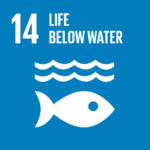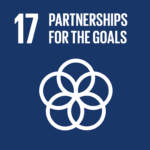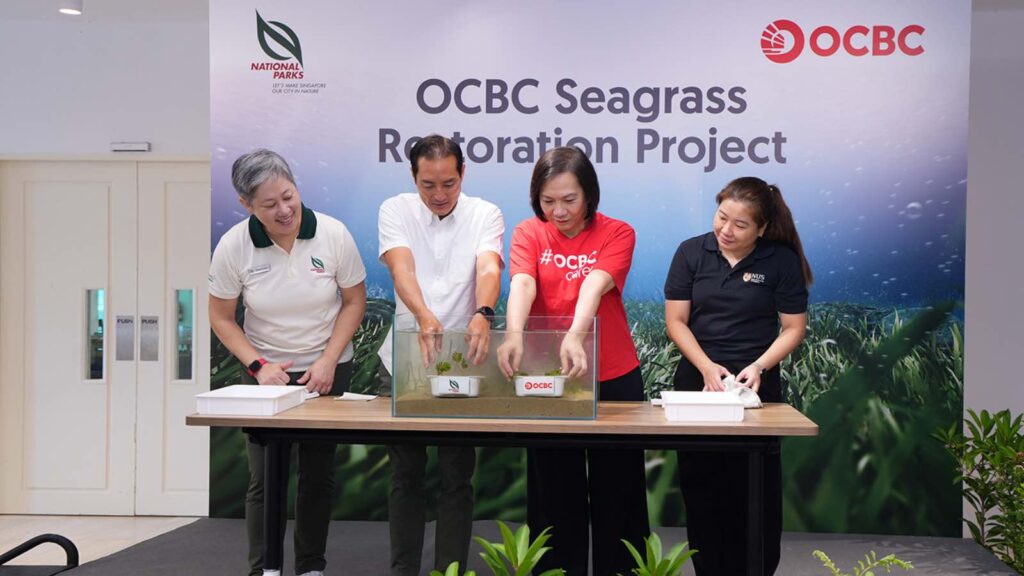OCBC and NParks announce Singapore’s first seagrass restoration project to study seagrass and enhance conservation efforts.
Along the coastal waters of Singapore, a quiet but critical battle against climate change is about to unfold. Today, OCBC and the National Parks Board (NParks) announced a bold new initiative: Singapore’s first-ever seagrass restoration project. This ambitious undertaking, fully funded by OCBC, aims to unlock the secrets of one of the ocean’s most powerful carbon-storing ecosystems—seagrass meadows—while spearheading local conservation efforts.
RELEVANT SUSTAINABLE GOALS



A Hidden Superhero in the Fight Against Climate Change
Often overlooked, seagrass meadows are quietly playing a pivotal role in the global fight against climate change. Despite covering just 0.2% of the world’s ocean floor, these underwater meadows store a remarkable 18% of oceanic carbon—up to 40 times more effectively than terrestrial forests. Beyond their ability to sequester carbon, seagrass meadows provide critical habitats for marine species, act as natural barriers against coastal erosion, and support biodiversity.
But seagrass meadows are under threat. Over the last five decades, Singapore alone has lost more than 45% of its seagrass habitats due to pollution, shoreline modification, and the effects of climate change. With these meadows shrinking, both marine life and climate mitigation efforts face a significant challenge.
A Partnership with Purpose: OCBC and NParks Join Forces
The OCBC Seagrass Restoration Project, announced today, signals a major step forward in Singapore’s conservation efforts. The initiative brings together the expertise of NParks, the National University of Singapore (NUS), and funding from OCBC to tackle the decline of seagrass meadows. Researchers will study the reproductive characteristics of tropical seagrass and experiment with innovative methods to improve transplant success rates in Singapore’s challenging coastal waters.
This pilot project is not just about restoring seagrass—it’s about understanding how to ensure these critical plants thrive for future generations. “Seagrass meadows are a significant part of Singapore’s natural heritage,” said Mr. Tan Kiat How, Senior Minister of State for Digital Development & Information and National Development. “They provide food and shelter for marine species, contribute to carbon sequestration, and protect our coastlines.”
For OCBC, this project is the latest in a series of climate action initiatives in partnership with NParks. From reforesting Coney Island to establishing the OCBC Arboretum and OCBC Mangrove Park, the bank has been at the forefront of efforts to restore Singapore’s natural habitats. Together, these projects aim to absorb more than 110 million kilograms of carbon dioxide—a tangible step toward mitigating climate change.
The Science Behind the Restoration: What’s at Stake?
The success of this project will hinge on new methods for seagrass transplantation. Seagrass transplants often face low survival rates due to the complex, underwater conditions that make it difficult for the plants to take root and reproduce. By focusing on the reproductive traits of tropical seagrasses, researchers hope to improve transplant techniques and ensure long-term survival.
In addition to transplantation, the study will also quantify both the tangible and intangible benefits of seagrass restoration. This includes measuring the increase in carbon sequestration and biodiversity that thriving seagrass meadows can provide.
“We want to make a big impact with projects that matter,” said Ms. Helen Wong, Group CEO of OCBC. “Whether it’s the dipterocarp trees in our arboretum, the mangroves in our park, or seagrass in this new project, these ecosystems serve as highly effective carbon sinks. This isn’t just about research—it’s about action.”
A Call for Citizen Scientists: Get Involved
What makes this project unique is its inclusion of the public. OCBC and NParks are inviting members of the community to get involved as “citizen scientists.” Volunteers will have the opportunity to participate in the seagrass transplanting process and conduct surveys to track the plants’ growth and reproduction, including flowering patterns.
“We want our staff and the public to feel like they are a part of something bigger,” Ms. Wong explained. “Not only will they be helping the environment, but they’ll also be directly contributing to groundbreaking research.”
Volunteers will play a critical role in gathering data that will shape the future of Singapore’s seagrass meadows. More information on how to get involved will be announced soon, offering a rare chance for individuals to engage in meaningful environmental work.
A Blueprint for the Future
If the pilot proves successful, the OCBC Seagrass Restoration Project could set the stage for future efforts to restore seagrass meadows across Singapore. The findings from the study will contribute significantly to national conservation strategies and inform future seagrass transplantation methods.
With the potential to improve coastal protection, boost biodiversity, and capture carbon, restoring Singapore’s seagrass meadows offers a powerful solution to some of the biggest challenges facing the planet. This project, alongside OCBC’s previous efforts, is not just about saving seagrass—it’s about safeguarding the future of our climate and our communities.
Lead image courtesy of OCBC (From L to R: Ms Hwang Yu-Ning, CEO, NParks; Mr Tan Kiat How, Senior Minister of State for Digital Development & Information and National Development; Ms Helen Wong, Group CEO, OCBC; and Dr Theresa Su, Lecturer, NUS.)



